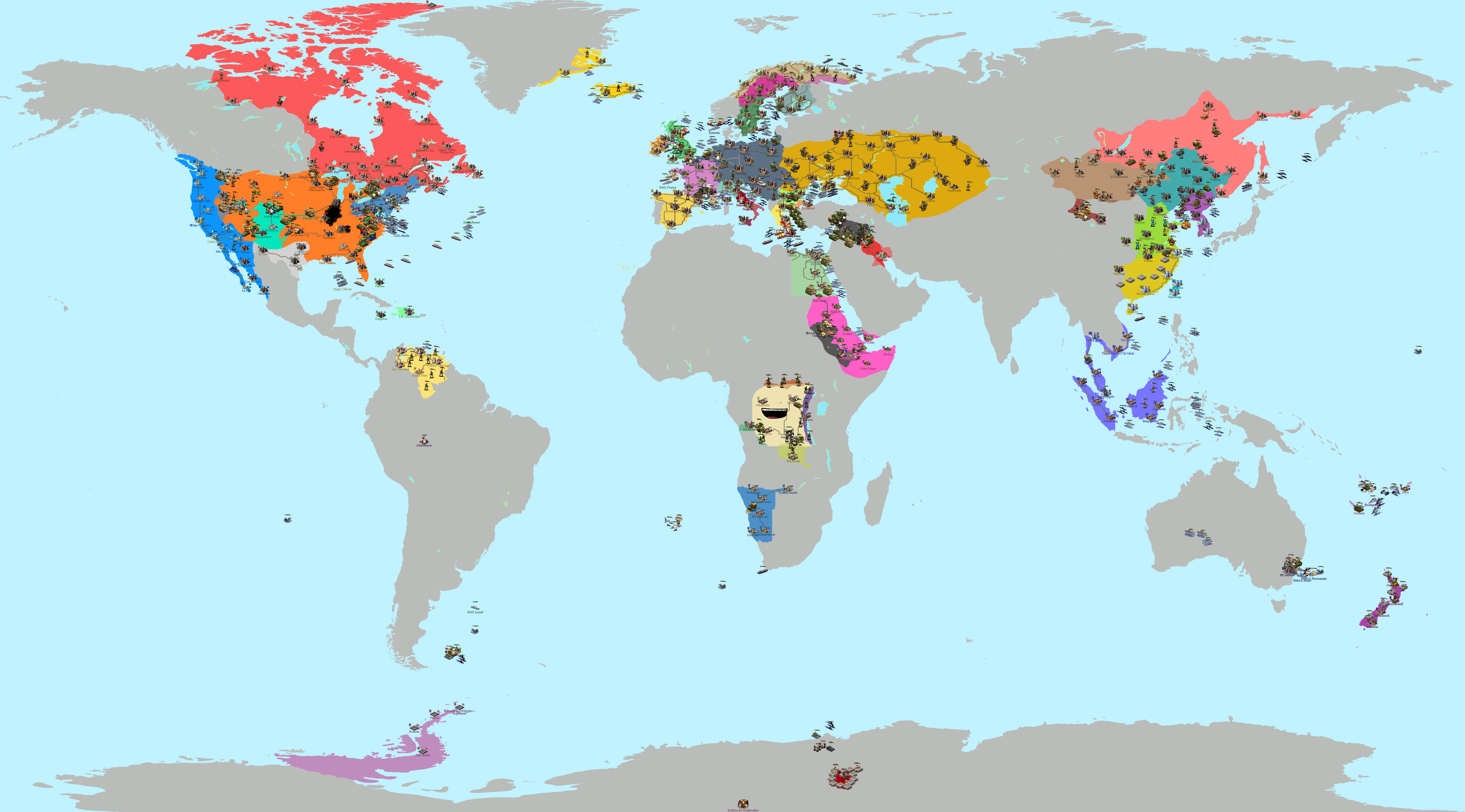Thorvald of Lym
A Little Sketchy
MARCH, 2017. The world struggles to rebuild after a cascade of calamities. Between organized crime's assassination of the President of the United States and the Mexican invasion, and NATO's campaign against the radical hoplitejoe's rhinoceros insurgency and the Namibian civil war, the last thing Earth needed was a genocidal conspiracy. But, thanks to the valiant initiative of the "African Group", the diabolical Eternal Kingdom's bloody train was derailed before it could smother the world in murderous tyranny.
But in world war's wake, global politics has been completely upended as once-great nations lie in ruin. With the old order in disarray, power vacuums abound, beckoning to reformers and usurpers alike. That's why you're here: every crisis heralds opportunity, and in the post-war free-for-all you see a chance to stake out your own maverick path in this brave new dawn.
You've made it out of Dodge; now it's time to

Welcome, one and all, to the sequel that yet simultaneously inspired Roll to Rule by Terran Empress! Inspired by Seon's Roll to Dodge seen in Forum Games, Roll II Rule extrapolates the insanity of my own Ludicrous Edition into the political sphere.
The base rules are so simple, even Byzieboos can understand:
Initial success is determined on a score of 1–20, with the final result adjusted by various acquired modifiers. Score breakdown is as follows:
Under binary conditions, 1-10 fails, 11-20 succeeds.
Note that attempting an action requiring an intermediate action (i.e. starting a car with no keys) automatically fails. Also note that the same action cannot be taken twice in a row. Take heed that your GM is unstable, and may tweak the playing field independent of player actions. Almost anything goes, but be warned that metagaming will anger the D1C3 G0D, who may unleash the wrath of Dr. Hax upon you.
"So what's different from Terra's game?"
Good question! (Although I was withholding the answer for dramatic effect.) Whereas previous R2D spin-offs essentially play like RISK, Roll II Rule remains character-centric: there are no fixed borders, no real win/loss conditions, and no (theoretical) limits on how you choose to play. The biggest change is that players are limited to one action per turn, at least at the outset.
"I'm here from Round 4. What's different from how we played there?"
Nothing really, except now we have tons more pictures!
"Oh come on, it can't be that simple!
Well if you're gonna insist, here's a quick breakdown of salient features. The basic map operates on four levels: Players, Units, Cities, and Infrastructure.
"Are there really no other rules?"
Alright, you got me. Here are some further considerations:
"By reading this post, I have implicitly agreed to the terms of service, including that clause stating they my be changed arbitrarily at any time. How do I join?"
Welcome aboard! Pick a name for your country (if you want one), a national flag (if you use one), and a map colour (preferably soft pastel hues so it won't clash with map icons). Then describe your first action.
...Actually, let me clarify something to make sure there's no confusion.
Your national bio counts as your first action.
IOTers are all helpless egotists at heart, so describe your country (or yourself!) in as much or as little detail as you wish. First update will determine how much your dream matches reality in terms of controlled territory, population, standing military, and et cetera.
Also, don't be surprised if a handful of players start with ludicrous bonuses off the bat—they won in R2D, so they deserve their prizes.
Lastly: Have Fun!
Fun is mandatory. Anyone not having fun may be evicted without notice.
But in world war's wake, global politics has been completely upended as once-great nations lie in ruin. With the old order in disarray, power vacuums abound, beckoning to reformers and usurpers alike. That's why you're here: every crisis heralds opportunity, and in the post-war free-for-all you see a chance to stake out your own maverick path in this brave new dawn.
You've made it out of Dodge; now it's time to

Welcome, one and all, to the sequel that yet simultaneously inspired Roll to Rule by Terran Empress! Inspired by Seon's Roll to Dodge seen in Forum Games, Roll II Rule extrapolates the insanity of my own Ludicrous Edition into the political sphere.
The base rules are so simple, even Byzieboos can understand:
1. Post an action.
2. Your result will be determined by the roll of a die.
Any action that triggers a third-party attack on the player immediately grants a free defence roll.
2. Your result will be determined by the roll of a die.
Any action that triggers a third-party attack on the player immediately grants a free defence roll.
Initial success is determined on a score of 1–20, with the final result adjusted by various acquired modifiers. Score breakdown is as follows:
1 : Unbelievably total failure. Action WILL backfire.
2-4 : Failure, with penalty
5-7 : Marginal failure with possible penalty
8-10 : Failure, no penalty
11-13 : Straightforward success
14-16 : Success, with possible bonus
17-19 : Success, with circumstantial bonus
20 : MAXIMUM POWER. Guaranteed success, with added bonus.
2-4 : Failure, with penalty
5-7 : Marginal failure with possible penalty
8-10 : Failure, no penalty
11-13 : Straightforward success
14-16 : Success, with possible bonus
17-19 : Success, with circumstantial bonus
20 : MAXIMUM POWER. Guaranteed success, with added bonus.
Under binary conditions, 1-10 fails, 11-20 succeeds.
Note that attempting an action requiring an intermediate action (i.e. starting a car with no keys) automatically fails. Also note that the same action cannot be taken twice in a row. Take heed that your GM is unstable, and may tweak the playing field independent of player actions. Almost anything goes, but be warned that metagaming will anger the D1C3 G0D, who may unleash the wrath of Dr. Hax upon you.
"So what's different from Terra's game?"
Good question! (Although I was withholding the answer for dramatic effect.) Whereas previous R2D spin-offs essentially play like RISK, Roll II Rule remains character-centric: there are no fixed borders, no real win/loss conditions, and no (theoretical) limits on how you choose to play. The biggest change is that players are limited to one action per turn, at least at the outset.
"I'm here from Round 4. What's different from how we played there?"
Nothing really, except now we have tons more pictures!

"Oh come on, it can't be that simple!
Well if you're gonna insist, here's a quick breakdown of salient features. The basic map operates on four levels: Players, Units, Cities, and Infrastructure.
- Players are each represented by an in-game avatar who is the de facto leader of the starting faction. KEEP YOURS ALIVE! While you can be ousted from power, or lose your entire country in military conquest, as long as your avatar still exists, you're still in the game. N.B.: You can't have a country without an avatar, but you can play the game without a country. I'll try to match your avatar either to your persona or signup as best I can; I'll also take custom submissions provided they fit the format.
- Units are all the mobile actors that appear on the map, i.e. non-player characters, vehicles, animals, and so forth. Units can be anything from citizens to political officials to enlisted soldiers, and range in size from individual actors to entire military formations. Each has its own set of statistics, and operates with varying degrees of autonomy. Just because you're from different states doesn't mean you can't interact with foreign actors at a personal level (where applicable); likewise, just because you share nationality doesn't mean they'll necessarily be friendly. As with the player avatar, I'll try to match unit styles to faction aesthetics, and players can submit specific schemes.
- Cities are the primary economic actors at the political level. Like Units, they have unique statistics, though exactly what will depend on what is demanded by player actions, but can be assumed the main sources for aggregated population, economic and industrial productivity, and siting for permanent structures. Like Units, Cities can range in size from rural hamlets to megalopolises and are semi-autonomous. A faction's starting cities are dispersed according to initial signup, and more can be founded through player initiative.
- Infrastructure is basically a catch-all for actors not already described. This includes roads and railways, airports and bunkers, and standalone buildings not tied to cities. Once again, possibilities are theoretically unlimited: if you can dream it, you can build it.
"Are there really no other rules?"
Alright, you got me. Here are some further considerations:
- All orders must be publicly posted in this thread. Format it however you want; just make sure I know what you're trying to do.
- All players begin with one action per turn. You can, however, expand your actionability either by levelling up your avatar or hiring support staff. Or both. By default, extra actions apply to state administration and equivalent functions—physical actions pertaining to the player avatar (i.e. multiple attacks per turn) will be stated explicitly. In order to reduce the tedium of large commands, you can give groups of units general orders and they will carry them out on their own initiative. N.B.: Do not mistake this for trying to string a series of sub-orders into one action. In the event of multiple/conflicting orders, I'll roll for priority.
- Don't 'game' orders to invoke stats combos. I want this game to be free-flowing, and nothing torpedoes immersion like a half-paragraph justification of contrived conditions. Anyone that pulls a Dhoomstriker will be punished.
- Talking is a free action. Diplomacy isn't. Inter-player negotiations can occur anywhere and any time, but actually enacting the treaty requires you to roll for it to take effect on your side. Note that as per All Orders Must Be Public, "secret" alliances are disregarded when calculating NPC behaviour—trying to skirt this may lead to unforeseen consequences.
"By reading this post, I have implicitly agreed to the terms of service, including that clause stating they my be changed arbitrarily at any time. How do I join?"
Welcome aboard! Pick a name for your country (if you want one), a national flag (if you use one), and a map colour (preferably soft pastel hues so it won't clash with map icons). Then describe your first action.
...Actually, let me clarify something to make sure there's no confusion.
Your national bio counts as your first action.
IOTers are all helpless egotists at heart, so describe your country (or yourself!) in as much or as little detail as you wish. First update will determine how much your dream matches reality in terms of controlled territory, population, standing military, and et cetera.
Also, don't be surprised if a handful of players start with ludicrous bonuses off the bat—they won in R2D, so they deserve their prizes.

Lastly: Have Fun!
Fun is mandatory. Anyone not having fun may be evicted without notice.
Last edited:








.svg/1280px-Union_flag_1606_(Kings_Colors).svg.png)








